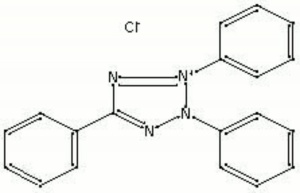Triphenyltetrazolium chloride
Jump to navigation
Jump to search
Description
Colorless needle crystals that yellow when exposed to light. Triphenyltetrazolium chloride (TTC) is primarily used as an analytical reagent for the detection of reducing sugars in plant and animal tissues. The colorless TTC reacts with sugars to become a deep red, water-insoluble compound (triphenylformazan). Reducing agents (i.e. borohydride, Bleaching powder, Chloramine T) give a positive red result.
Synonyms and Related Terms
TTC; TPTZ; red tetrazolium; tetrazolium chloride; 2,3,5-triphenyl-2H-tetrazolium chloride; Vitastain; tetrazole red
Risks
- Flammable. Flash point = 40C
- Contact causes irritation.
- Fisher Scientific: MSDS
Physical and Chemical Properties
Soluble in ethanol, water, acetone. Insoluble in ether.
| Composition | C19H15ClN4 |
|---|---|
| CAS | 298-96-4 |
| Melting Point | 243 C (dec) |
| Molecular Weight | mol. wt. = 334.5848 |
Resources and Citations
- Richard S. Lewis, Hawley's Condensed Chemical Dictionary, Van Nostrand Reinhold, New York, 10th ed., 1993
- Richard C. Wolbers, Nanette T. Sterman, Chris Stavroudis, Notes for Workshop on New Methods in the Cleaning of Paintings, J.Paul Getty Trust, Los Angeles, 1990
- The Merck Index, Martha Windholz (ed.), Merck Research Labs, Rahway NJ, 10th edition, 1983 Comment: entry 9874
- Aldrich Chemical Catalog Comment: p. 1502
